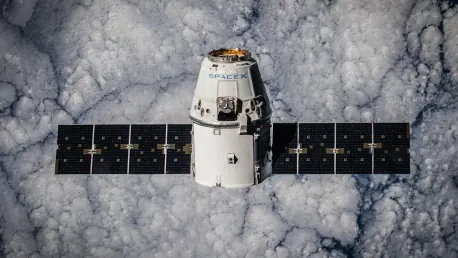SpaceX’s Starlink satellite constellation is set to transform global telecommunications by offering direct-to-cellphone connectivity. This groundbreaking innovation aims to eliminate dead zones and provide internet access in even the most remote areas, leveraging advanced satellite technology to achieve this ambitious goal. Such a transformation could potentially redefine how telecommunications systems operate, breaking down barriers that have traditionally hindered sustainable connectivity across the globe.
Technological Advancements in Starlink Satellites
Significant technological breakthroughs define the advancements SpaceX has introduced with its Starlink satellites. These satellites are equipped with state-of-the-art software algorithms, phased array antennas, and custom silicon, strategically designed to tackle inherent challenges characteristic of satellite networks. Moreover, a crucial component, the eNodeB modem, enables the satellites to function similarly to mobile towers, providing seamless network integration that mimics standard roaming partners. Such technology is instrumental in ensuring a consistent user experience across various geographical regions, regardless of terrestrial infrastructure limitations.
Cutting-Edge Satellite Technology
As innovations push the bounds of traditional satellite communications, the advanced software algorithms embedded in Starlink satellites lend them a unique edge. These algorithms, in conjunction with phased array antennas, optimize signal reception and transmission, even in less than ideal atmospheric conditions. The custom silicon integrated within the satellites enhances processing power and supports complex operational functions essential for maintaining a robust and reliable network infrastructure. By effectively bridging the gap between terrestrial mobile networks and space-based technology, Starlink sets a precedent for future advancements in satellite communication.
Further enhancing their capabilities, eNodeB modems are central to this technological overhaul. These modems enable satellites to emulate ground-based mobile towers, offering connectivity comparable to conventional mobile networks. Users experience seamless network integration, akin to standard roaming services, without the typical constraints of coverage gaps. Consequently, this innovation brings the promise of reliable connectivity to underserved and remote regions, fostering digital inclusion on a global scale.
Reusability and Cost Efficiency
While technological upgrades are pivotal, equally essential is the efficiency of the deployment mechanisms. Herein, the reusable Falcon 9 rocket, a cornerstone of SpaceX’s launch system, plays a transformative role. This rocket drastically reduces the costs associated with accessing space, an otherwise expensive and resource-intensive endeavor. By reusing a significant portion of Falcon 9’s most costly components, SpaceX achieves remarkable cost-efficiency and sustainability. To date, Falcon 9 has completed over 407 launches and 336 reflights, a testament to its reliability and operational success.
The economic viability ushered in by Falcon 9’s reusability extends beyond mere cost-saving. It enables frequent launches, ensuring the timely expansion and maintenance of the Starlink satellite constellation. This frequent launch cadence is crucial for replenishing and augmenting the satellite network, thereby sustaining continuous and expanding global coverage. Consequently, the cost efficiencies realized through this reusable rocket underpin the broader strategic vision of making universal connectivity both feasible and sustainable.
Global Coverage Ambition
Starlink’s ambition to provide comprehensive global coverage hinges on its dense and strategically deployed satellite constellation. With recent successful launches, SpaceX has completed the first orbital shell, marking a significant milestone towards its goal of building the largest satellite network. Achieving this feat ensures the deployment of approximately 350 spacecraft, each capable of establishing direct connections to cellphones. This infrastructure is paramount in eliminating coverage gaps, offering ubiquitous connectivity irrespective of geographical and infrastructural constraints.
Building the Largest Satellite Network
SpaceX’s strategic blueprint involves progressively augmenting its network, ensuring incremental yet impactful improvements in satellite capabilities. The first orbital shell’s completion signifies a foundational stage in this expansive project, heralding the deployment of additional spacecraft to broaden the coverage net. These satellites, fostering direct connections to mobile devices, herald a new era in connectivity by seamlessly integrating with existing mobile networks. This capability is instrumental in providing consistent and reliable internet access to users globally, especially in otherwise inaccessible regions.
The vision of vast global coverage is not merely aspirational but increasingly attainable through meticulous and phased implementations. Future constellations promise even greater advancements, driven by ongoing technical enhancements and dynamic deployment strategies. As additional satellites join the network, the cumulative effect enhances system resilience and reliability, ensuring users enjoy uninterrupted connectivity services across an ever-expanding footprint.
Bandwidth and Connectivity Goals
Another critical aspect of Starlink’s mission is its resolute focus on increasing bandwidth capacity and connectivity quality. Currently, the bandwidth per beam stands at around 10Mb, reflecting an upgrade from 7Mb earlier in the year. This progression underscores SpaceX’s commitment to continually elevating performance standards, ensuring a better user experience. With ambitions to support text services for LTE phones worldwide by 2024, Starlink’s trajectory includes robust plans for extending voice, data, and IoT device connectivity in subsequent phases.
Projected enhancements in future constellations promise significant bandwidth upgrades, vital for catering to increasing user demands. Augmented bandwidth capability directly translates into higher data transmission speeds, reduced latency, and improved service reliability. This bandwidth expansion is crucial for accommodating diverse communication services, ranging from basic text services to advanced data and IoT applications, thereby driving the global digital ecosystem’s evolution.
Funding and Future Missions
Revenue generation from Starlink’s services is integral to funding SpaceX’s broader and more ambitious endeavors, notably its Mars colonization program. Dubbed “Occupy Mars,” this initiative aims to pioneer crewed missions to Mars, with a target launch year of 2028. The interconnection between current commercial success and future extraterrestrial aspirations highlights the strategic importance of Starlink’s comprehensive financial viability. Amidst these grand visions, securing regulatory milestones and executing successful testing protocols remain pivotal elements.
Revenue Generation for Mars Colonization
Starlink’s revenue streams are not merely designed for reinvestment into satellite technology but also to finance SpaceX’s grander visions of Mars colonization. This initiative underscores the strategic foresight ingrained within SpaceX’s operational philosophy, blending terrestrial and extraterrestrial missions. The goal of sending human crews to Mars by 2028 signifies a landmark ambition, marking a pivotal moment in human space exploration. Starlink’s financial success thus becomes the bedrock for these future celestial undertakings, testament to Elon Musk’s broader vision for human spaceflight.
The intrinsic link between robust telecommunications infrastructure and interplanetary exploration cannot be overstated. Effective and reliable communication channels are quintessential for the successful execution of long-duration space missions. As such, the financial gains from terrestrial internet services through Starlink directly support the development and execution of Mars missions. This integration of commerce and exploration defines a unique paradigm, emphasizing the transformative potential embedded within SpaceX’s operational strategies.
Regulatory and Testing Milestones
Achieving regulatory clearance is critical for operational legitimacy and expansion, and Starlink’s direct-to-cell program received such approval in the US only recently. This milestone represents a significant advancement in broadening the program’s applicability and ensuring regulatory compliance. Prior to this, SpaceX had already demonstrated its capabilities by successfully sending and receiving text messages using the T-Mobile network spectrum through Direct Cell satellites as early as January 2023. This preliminary success set the stage for more comprehensive testing and regulatory benchmarks.
Comprehensive testing protocols ensure that the infrastructure is both resilient and reliable, capable of withstanding operational exigencies. The rigorous testing regimen that Starlink undergoes is a testament to SpaceX’s commitment to maintaining high service standards. As regulatory landscapes evolve, continuous compliance ensures that Starlink’s services align with global norms, promoting broad acceptance and integration within diverse telecommunication frameworks. This structured approach to testing and regulatory approval is pivotal in fostering trust and ensuring long-term sustainability.
Strategic Partnerships
Forging collaborative ties with key stakeholders within the telecommunications industry is critical for Starlink’s widespread adoption and operational success. Partnerships with prominent mobile network operators worldwide, such as T-Mobile in the US, are fundamental in ensuring service compatibility with standard LTE phones. These alliances facilitate the integration of Starlink’s services within existing infrastructure, promoting seamless user experiences and broadening the potential user base. Such strategic collaborations underscore the synergetic potential between terrestrial and satellite communications.
Collaborations with Mobile Network Operators
The strategic alliances forged with mobile network operators form the backbone of Starlink’s operational strategy. These partnerships are instrumental in ensuring seamless integration with existing telecommunication networks, thereby facilitating widespread service adoption. In the United States, collaboration with T-Mobile exemplifies the potential of these partnerships, ensuring service compatibility with standard LTE phones. Additional partnerships, spanning operators like Optus in Australia and Rogers in Canada, extend Starlink’s reach, enabling a broad user demographic to access its services.
By providing ubiquitous coverage and eliminating dead zones, these partnerships enable Starlink to deliver consistent and reliable connectivity. The collaborative model adopted by SpaceX through these alliances facilitates optimal resource utilization, leveraging existing infrastructures while enhancing service delivery capabilities. As Starlink continues to expand its network, these foundational partnerships remain critical in driving systemic adoption and operational success.
Laser-Based Optical Communication
In enhancing communication efficiency and security, Starlink employs laser-based optical communication systems between its satellites. This technology surpasses conventional radio frequency communications by offering data transmission rates up to 100 times faster. The laser-based systems ensure rapid and secure data exchanges between satellites, effectively mitigating latency issues and enhancing overall network performance. This technological prowess underpins the robustness and reliability of Starlink’s global communication infrastructure.
Laser communication not only enhances speed but also ensures higher security standards for data transmissions. The intrinsic properties of light-based communication render it less susceptible to eavesdropping compared to traditional methods, thereby safeguarding user data. This dual enhancement of speed and security epitomizes the technological sophistication embedded within Starlink’s framework, reinforcing its position at the forefront of satellite communication advancements. As the network evolves, laser-based optical communication remains pivotal in sustaining Starlink’s competitive edge.
Competition and Market Presence
Starlink operates within a competitive landscape, marked by the presence of entities like Lynk Global and AST SpaceMobile. Both companies strive to provide global satellite-to-mobile phone connectivity, positioning themselves as formidable competitors. Similar to Starlink, these entities have operational satellites and have established partnerships with various governmental and commercial bodies. The competitive dynamics within this space incentivize continuous innovation, ensuring that Starlink remains at the vanguard of technological advancements and service delivery.
Competitors in Satellite-to-Mobile Connectivity
Navigating a competitive market requires an acute awareness of peer innovations and strategic positioning. Competitors like Lynk Global and AST SpaceMobile share the ambition of providing global satellite-to-mobile phone connectivity, thereby intensifying market competition. Both firms have operational satellites, similar to Starlink, and have forged strategic ties with various governmental and commercial entities. These partnerships enhance their market presence and operational capabilities, signifying the competitive nature of this landscape.
However, Starlink’s advanced technological framework and strategic alliances are pivotal differentiators. The integration of cutting-edge technologies such as phased array antennas, custom silicon, and laser-based communication systems positions Starlink as a frontrunner. Moreover, the robust partnerships with established mobile network operators globally amplify its competitive advantage, facilitating a broader and seamless service delivery. As competition heats up, continuous innovation and strategic collaborations ensure that Starlink maintains its market-leading position.
Military and Government Applications
Beyond commercial ventures, Starlink’s applications extend into critical military and government domains. The encrypted Starshield service exemplifies this, gaining traction in military applications by providing secure and reliable connectivity. A notable instance is its usage by the US government to support internet connectivity in Ukraine amidst ongoing conflict. This deployment underscores Starlink’s strategic value in critical situations, demonstrating its utility in supporting essential operations and communication needs during crises.
The military domain’s reliance on secure and dependable communication channels underscores the importance of Starlink’s encrypted services. Starshield’s deployment within such contexts ensures that mission-critical operations have unimpeded and secure communication capabilities, vital for strategic planning and execution. As geopolitical dynamics evolve, Starlink’s role within the military and government communication framework becomes increasingly indispensable, reinforcing its strategic significance beyond conventional commercial applications.
Global Adoption and Challenges
While Starlink’s adoption expands globally, it must navigate diverse regulatory landscapes and operational challenges. Adoption by airlines and availability in beta form across select regions exemplify its growing footprint. However, regulatory hurdles persist in certain countries, such as Namibia, and potentially in tech-regulated regions like China. Navigating these challenges is imperative for sustained global expansion and operational uniformity. Simultaneously, financial metrics highlight rapid subscriber growth and significant revenue projections, underpinning SpaceX’s strategic focus on enterprise and government markets.
Expanding Services and Overcoming Regulatory Hurdles
Starlink’s global expansion embodies a dynamic interplay between service deployment and regulatory compliance. While its adoption by various airlines illustrates expanding service parameters, regulatory challenges in specific regions remain formidable. In countries like Namibia and potentially China, stringent regulatory frameworks present obstacles that must be adeptly navigated to achieve seamless integration. Overcoming these regulatory hurdles is non-negotiable for Starlink’s ambition to actualize ubiquitous connectivity on a global scale.
Strategic engagement with regulatory authorities and compliance with local telecommunication policies are pivotal in surmounting these challenges. Tailoring deployment strategies to align with regional regulations ensures smoother implementation and operational consistency. These efforts underscore the importance of regulatory agility and strategic policymaking in driving Starlink’s global ambitions. As the service expands, continuous engagement with regulators is crucial in fostering a conducive operational environment, ensuring sustained service delivery across diverse landscapes.
Financial and Subscriber Growth
SpaceX’s Starlink satellite constellation is poised to revolutionize global telecommunications by providing direct-to-cellphone connectivity. This groundbreaking innovation aims to eradicate dead zones and enable internet access in even the most remote corners of the world, using advanced satellite technology to achieve this far-reaching goal. By facilitating connectivity in places that have historically been cut off due to geographic or infrastructural challenges, Starlink has the potential to completely redefine how telecom systems operate.
Currently, many rural and isolated regions lack reliable internet and cell service, creating significant communication barriers. Starlink’s vision involves deploying thousands of small satellites in low Earth orbit to create a network that ensures seamless, high-speed internet coverage, no matter where you are on the planet. This not only signifies an advancement in technology but also promises to democratize access to information and communication tools.
The implications of this technology are vast; it could bridge the digital divide, spur economic growth, and improve access to education and healthcare services in underserved areas. Additionally, it challenges traditional telecom models, forcing them to innovate and improve their services to stay competitive. By breaking down these long-standing barriers, SpaceX’s Starlink could be a game-changer for global connectivity, making the dream of a truly connected world a reality.









